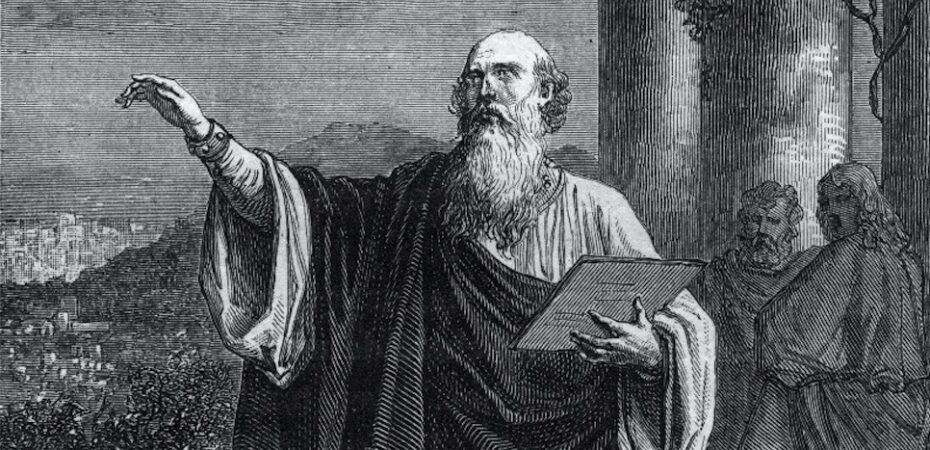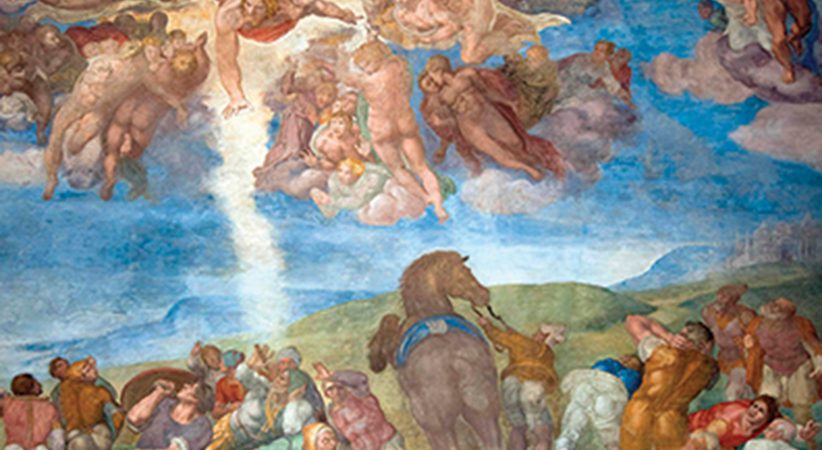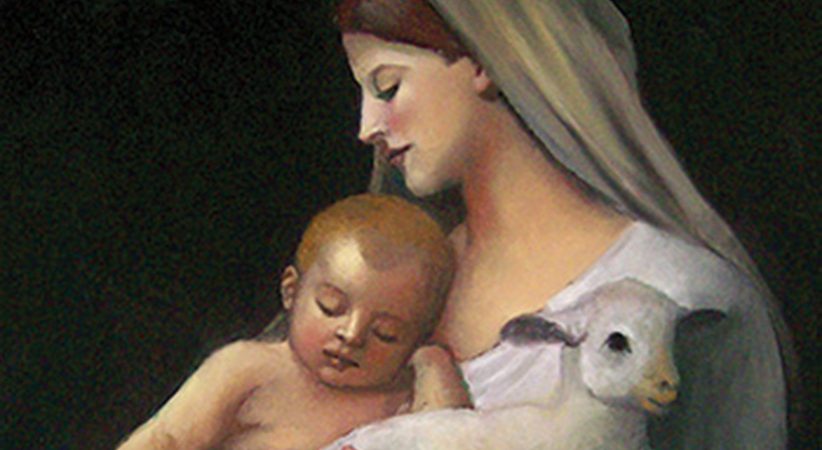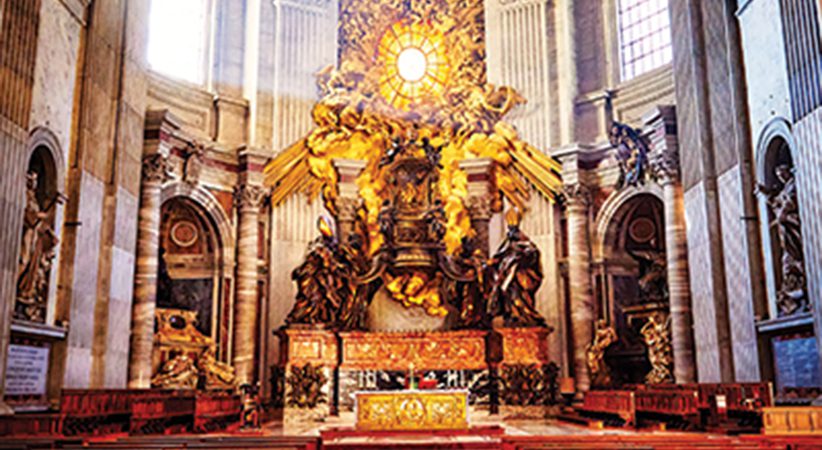An Overdue Award for St. Irenaeus
This Doctor of the Church committed his life to serving God
D.D. Emmons Comments Off on An Overdue Award for St. Irenaeus
When Pope Francis decreed on Jan. 21 St. Irenaeus (c. A.D. 130-202) a Doctor of the Church, many Catholics were surprised, as many thought that Irenaeus was already so honored. But when we take the time to look at that list of Doctors, 36 holy men and women, we discover that he is not. He is the second person named as a Doctor of the Church by Pope Francis. The other is St. Gregory of Narek who was named a Doctor in 2015.
Irenaeus is considered the greatest theologian of the second century and one of the greatest ever. Using the word esteemed to characterize this holy man would not be an overstatement. He was born in the East, at Smyrna (present-day Izmir, Turkey) around A.D. 130, only a generation removed from the time when the apostles of Jesus were spreading the Gospel. Irenaeus was a follower of St. Polycarp who in turn was taught by the apostle St. John. The details of Irenaeus’ life are hard to come by.
In the mid-second century, he migrated to the city of Lugdunurn in Gaul, today Lyon, France. At that time, Christianity was spreading into that area of the world, and Irenaeus went there to help in the evangelization effort. His work earned him the good graces of the local bishop, Pothinus, and around 175 Irenaeus was sent as a representative of the bishop to Rome. During his absence, a severe persecution was brought on the Christians in and around Lyon.
The persecutions were carried out by local citizens suspicious of the Christians, who were believed to eat the flesh of children and to engage in love orgies. Nearly 50 Christians, including priests, were martyred. Bishop Pothinus was jailed where he would eventually die.
Irenaeus returned to Lyon in 177 and was immediately elected bishop. He successfully faced the task of restoring and keeping the Church together. But his problems were just beginning as many of the pagans in Gaul were influenced by heretical beliefs of the day and wanted to impose their own brand of Christianity. Mostly, these heretics were followers of Gnosticism.
Gnosticism
Gnostics had beliefs that were all over the map, most of which were implausible. There was not just one sect or group but numerous branches with various beliefs. The common denominator seemed to be the belief that the world was divided into good and evil (Dualism). All matter, all material things were evil, including a person’s body, marriage and procreation. Thus God, who is all good, did not create the world; they divided the Creator from his creation. Many Gnostics concluded that there was no Incarnation, that Jesus was not really human but only a vision or mystic and did not die on the cross, that only a select few with a special knowledge could ever attain eternal life. They abandoned the Old Testament and refused to accept the simplicity of the Gospel and the sacred Scriptures — it had to be more complicated — something beyond the intellect of the common person.
The heretics were spreading their absurdities throughout France and Irenaeus would rail against these confused and misguided people. “Gnosticism is the name given to a variety of movements, most of them pagan but some ostensibly Jewish or Christian. At stake was the most fundamental of all the teachings of the Judeo-Christian faith — that one God created the universe and rules over it. Gnosticism, by contrast, was fundamentally dualist, positing two equal gods ruling two wholly separate realms of the universal-spiritual and material, light and dark, good and evil,” writes James Hitchcock in his “History of the Catholic Church” (Ignatius, $34.95).
Irenaeus’ Response
Irenaeus recognized that if not challenged Gnosticism would transform the Church into a set of meaningless beliefs and falsehoods. In his five-volume classic, “On the Detection and Overthrow of the So-called Gnosis” (Against Heresies — c. 180), he methodically rebukes the confusing teaching of these vile heretics while providing a clear, uncomplicated explanation of Christian beliefs. He uses historical arguments, uses the words of those witnesses to Christ, repeatedly uses the Scriptures, even uses the contradictions among the various Gnostic groups to underscore the flaws of their philosophy, while describing the authentic message of the Church: a message of truth and one that is available to all, not to a chosen few.
He wrote: “In the Church, God has placed apostles, prophets and doctors, and all the other means through which the Spirit works; in all of which none have any part who do not conform to the Church. On the contrary, they defraud themselves of life by their wicked opinion and most wretched behavior. For where the Church is, there is the Spirit of God; and where the Spirit of God, there the Church and every grace. The Spirit, however, is Truth” (“Against Heresies,” Book III, 24, 1).
Irenaeus was the first of the early Church Fathers to perpetuate the concept of apostolic succession, that the teachings of the apostles are handed on to the bishops of each generation. Bishop Irenaeus, as mentioned, was a student of Bishop Polycarp who was the student of the apostle John — an unbroken link.
The first volume of Irenaeus’ work contains words that defined a “rule of faith,” a creed, for the faithful of the early Church, and it became a forerunner of the Apostles’ Creed: “For the Church, although dispersed throughout the world even to the ends of the earth, has received from the apostles and from their disciples the faith in one God, Father Almighty, the Creator of heaven and earth and sea and all that is in them; and in one Jesus Christ, the Son of God, who became flesh for our salvation; and in the Holy Spirit, who announced through the prophets the dispensations and the coming, and the birth from a Virgin, and the passion, and the resurrection from the dead, and the bodily ascension into heaven of the beloved Christ Jesus our Lord, and his coming from heaven in the glory of the Father to re-establish all things” (Book 1, 10, 1).
………………………………………………………………………………………………………………………………………………………..
SPECIAL TITLES
Some of the Doctors of the Church have been given special titles. St. Thomas Aquinas is known as the “Angelic Doctor,” Cyril of Alexandria is the “Doctor of the Incarnation” and St. John of the Cross is the “Mystical Doctor.” Pope Francis has indicated that St. Irenaeus should be known as “Doctor of Unity,” because he “was a great spiritual and theological bridge between Eastern and Western Christians.”
…………………………………………………………………………………………………………………………………………………………
Peacemaker
Around A.D. 190, a crisis arose in Irenaeus’ diocese that threatened the unity of the Christian faith in France. At that time, more Christians from Asia Minor and the East had migrated to France and the population of the followers of Christ in that land was growing. One of the long-held traditions from the Eastern Church was to celebrate Easter on the Passover, no matter what weekday the Passover fell on, and no matter that it was not a Sunday. They wanted to continue this tradition even though now they were part of the Roman Church. Pope St. Victor I (r. 189-99) took exception, saying he would excommunicate anyone who celebrated Easter on any day except Sunday. This became a major crisis, and it was Irenaeus who effectively convinced Pope Victor not to excommunicate these people. St. Irenaeus became a hero, a peacemaker, which in fact is what his name means.
This Church Father also authored “The Presentation of the Apostolic Preaching” (c. 200) as well as other writings of which only fragments remain. These texts promote the importance and effect of apostolic succession and expound on sacred Scriptures, sacred Tradition and the dogma of the Church. He illuminates Church teachings in such a way that his work is often regarded as the basis for the earliest Church catechism. Although we have his writings, we only know sketches of his life. This was a time when Romans were persecuting anyone who followed Christ. Bishop Irenaeus courageously wrote and spoke the truths of Christianity despite this threat.
Defender of the Faith
The Church holds that Irenaeus was martyred at the beginning of the third century. He was a defender of the faith more than 100 years before the great St. Athanasius rejected Arianism. A martyr, saint, bishop, Church Father and soon-to-be Doctor, Irenaeus’ entire life was given to God. Not unlike other Church Fathers, his work is inspired by a deep-rooted belief, a deep-rooted love of God and the Catholic Christian faith. Being elevated to a Doctor of the Church is widely seen as both a just and perhaps overdue reward.
D.D. EMMONS writes from Pennsylvania.
………………………………………………………………………………………………………………………………………………………….
Doctor of the Church Selection Criteria
The first Doctors of the Church were named by Pope Boniface VIII in 1298: St. Augustine, St. Ambrose, St. Jerome and St. Gregory the Great. They all possessed those virtues and qualifications of a Doctor of the Church that would become the criteria for selection under Pope Benedict XIV who reigned from 1740-58:
• Those considered must have possessed the heroic virtues and sanctity necessary for canonization. All 36 Church Doctors had already been elevated to sainthood before being considered.
• The individual must have written and spoken about the teachings of the Church credibly and authentically and their pronouncements ideally influence every era of Church history. The Latin word doctor means teacher; a Church Doctor is regarded as an eminently qualified teacher.
• A pope or Church general council must confer this distinctive title. Every Doctor to date has been named by a pope. Advising the pope in the selection process are the Vatican Congregations for the Causes of Saints and the Doctrine of the Faith.
…………………………………………………………………………………………………………………………………………………………..





